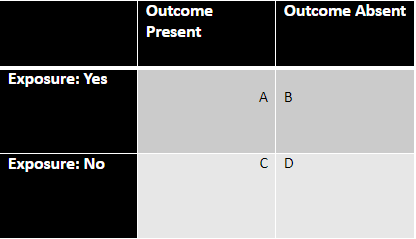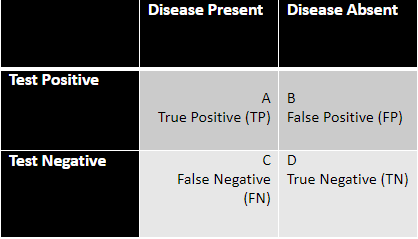| Therapy Calculations | |
|---|---|
| EER (Experimental Event Rate) | a/(a+b) |
| CER (Control Event Rate) | c/(c+d) |
| ARR (Absolute Risk Reduction | CER-EER |
| RR (Relative Risk) | EER/CER |
| RRR (Relative Risk Reduction) | ARR/CER |
| NNT (Number Needed to Treat) | 1/ARR |
| Harm Calculations | |
|---|---|
| EER (Experimental Event Rate) | a/(a+b) |
| CER (Control Event Rate) | c/(c+d) |
| ARI (Absolute Risk Increase) | EER-CER |
| RR (Risk Ratio) | EER/CER |
| NNH (Number Needed to Harm) | 1/ARI |
| OR (Odds Ratio. Used in case control) | (a*d)/(b*c) |
| Diagnosis Calculations | |
|---|---|
| Sensitivity (Sn) | TP/(TP+FN) |
| Specificity (Sp) | TN/(FP+TN) |
| Positive Predictive Value (PPV) | TP/(TP+FP) |
| Negative Predictive value (NPV) | TN/(FN+TN) |
| Likelihood Ratio (LR) + | Sn/(1-Sp) |
| Likelihood Ratio (LR) - | (1-Sn)/Sp |



Ask yourself: Was the study well-designed? Can/should I apply the results to my patient? What does my patient want?
Plain Language Summaries and Definitions
EER (Experimental Event Rate) = .001
"The risk of developing melanoma over 20 years in the (sunscreen) experimental group was 0.1% or 1 in 1000." OR "The proportion of those who developed melanoma over 20 years in the sunscreen group was 1 out of 1000." OR "The rate of developing melanoma in the sunscreen group was 0.1%"
CER (Control Event Rate) = .005
"The risk of developing melanoma over 20 years with placebo is 0.5%."
ARR (Absolute Risk Reduction) = CER-EER = .004 (Absolute Risk Increase is the opposite)
"Sunscreen use reduces the absolute risk of developing melanoma by 0.4%." OR "0.4% of patients, or 4 of 1000, are prevented from developing melanoma by using sunscreen." OR "For every 1000 patients using sunscreen, 4 cases of melanoma are averted."
NNT (Number-needed-to-treat) = 1/ARR = 250
"250 patients would need to be treated with sunscreen rather than placebo for 20 years to prevent one additional case of melanoma." NNH is the opposite.
RR (Relative Risk or Risk Ratio) = EER/CER = .20
- "People who use sunscreens for 20 years have less than a fifth of the risk of developing melanoma of those who use a placebo. Alternatively, people who do not use sunscreens have a 5 times greater risk of developing melanoma over 20 years as compared to those who use sunscreens." OR "The risk of melanoma without sunscreen is 5 times the risk with sunscreen."
- "The rate of melanoma with sunscreen is 20% of the rate without sunscreen." OR "Risk remaining": "Just 20% of the original risk of developing melanoma remains for those who use sunscreen."
RRR (Relative Risk Reduction) = (EER-CER)/CER or 1 – RR = .80
"Sunscreen use decreases the risk of developing melanoma by 80% compared with no sunscreen." OR "Risk removed": "80% of the risk of developing melanoma is removed by using sunscreen."
Duke Program on Teaching Evidence-Based Practice - https://sites.duke.edu/ebmworkshop/
- Sensitivity - The proportion of people with a positive test result among those with the target condition. (Sn)out – a negative highly sensitive diagnostic test rules out the disease.
- Specificity – The proportion of people with a negative test result among those without the target condition. (Sp)in – a positive highly specific diagnostic test rules in a disease.
- Likelihood ratios (- and +) – Used with pretest probability and a nomogram to determine post-test probability.
- Predictive Value - There are 2 categories of predictive value. Positive predictive value is the proportion of people with a positive test result who have the disease; negative predictive value is the proportion of people with a negative test result and who are free of disease. These are influenced by prevalence.
From JAMAEvidence
Assistance
Please feel free to email us at medlref@iu.edu or call (317) 278-3102.

This work is licensed under a Creative Commons Attribution 4.0 International License.

